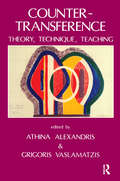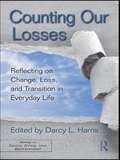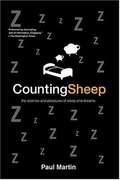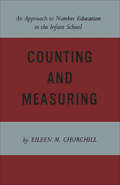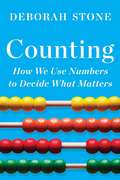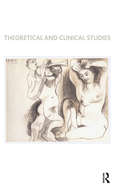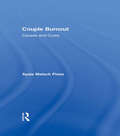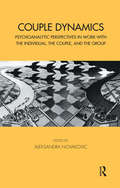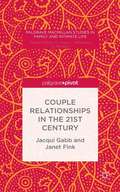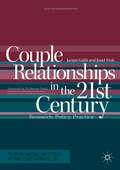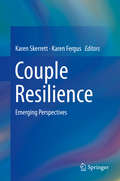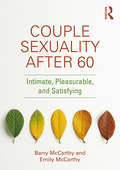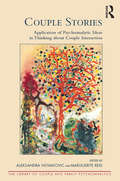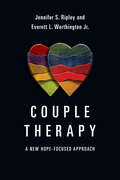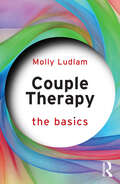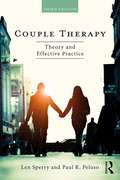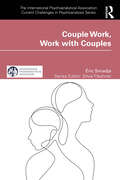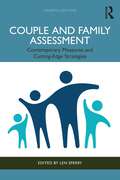- Table View
- List View
Countertransference: Theory, Technique, Teaching
by Grigoris Vaslamatzis Athina AlexandrisA collection of papers on the Oedipus complex, divided into three parts: theory, practice and supervision. The contributors, who include Joyce McDougall, Hanna Segal, Otto Kernberg and Leon Grinberg, invite the reader to explore with them the processes affecting the therapist's mind - and, occasionally his body - during psychoanalytic therapy, and the reasons why the therapist thinks, feels, and reacts in a particular way. The full significance of these processes, referred to as "counter-transference" since Freud's time, has recently been recognized, resulting in the therapist's use of additional resources so that he or she can understand and help the patient more effectively. In the 1950s and 1960s, Paula Heimann and Heinrich Racker, following on Freud's own observations, made important contributions to the study of the countertransference, considerably enlarging upon the concept and re-evaluating the nature of the psychoanalytic therapeutic relationship as a result.
Counting Backwards
by Laura LascarsoIn this haunting and hopeful debut novel, a teen's court-mandated psychiatric residency prompts a change in perspective from which there is no looking back.Taylor Truwell is a sixteen-year-old girl from Florida with a troubled past, a neglectful mother, a seemingly callous father, and an urge to flee. When Taylor is caught with a stolen car, her violent reaction lands her in court for resisting arrest. Her father convinces the judge of an alternative to punishment: treatment in a juvenile psychiatric correctional facility. And so Taylor arrives at Sunny Meadows. Sunny Meadows is anything but the easy way out, and Taylor has to fight hard just to hold on to her sanity as she battles her parents, an intrusive therapist, and a group of particularly nasty fellow patients. But even as Taylor clings to her stubborn former self, she gradually relents to new friendships--and to unexpected romance. Sunny Meadows goes against everything Taylor stands for. But could it be the place that saves her? In this striking debut, Laura Lascarso weaves together a powerful story of anger and self-destruction, hope and love, and the complicated way that it all comes together.
Counting Backwards
by Laura LascarsoIn this haunting and hopeful debut novel, a teen's court-mandated psychiatric residency prompts a change in perspective from which there is no looking back.Taylor Truwell is a sixteen-year-old girl from Florida with a troubled past, a neglectful mother, a seemingly callous father, and an urge to flee. When Taylor is caught with a stolen car, her reaction lands her in court for resisting arrest. Her father convinces the judge of an alternative to punishment: treatment in a juvenile psychiatric correctional facility. And so Taylor arrives at Sunny Meadows. Sunny Meadows is anything but the easy way out, and Taylor has to fight hard just to hold on to her sanity as she battles her parents, an intrusive therapist, and a group of particularly nasty fellow patients. But even as Taylor clings to her stubborn former self, she gradually relents to new friendships--and to unexpected romance. Sunny Meadows goes against everything Taylor stands for. But could it be the place that saves her? In this striking debut, Laura Lascarso weaves together a powerful story of anger and self-destruction, hope and love, and the complicated way that it all comes together.
Counting Down with You
by Tashie BhuiyanIn this sparkling and romantic YA debut, a reserved Bangladeshi teenager has twenty-eight days to make the biggest decision of her life after agreeing to fake date her school’s resident bad boy. <p><p> How do you make one month last a lifetime? <p> Karina Ahmed has a plan. Keep her head down, get through high school without a fuss, and follow her parents’ rules—even if it means sacrificing her dreams. When her parents go abroad to Bangladesh for four weeks, Karina expects some peace and quiet. Instead, one simple lie unravels everything. <p> <i>Karina is my girlfriend.</i> <p> Tutoring the school’s resident bad boy was already crossing a line. Pretending to date him? Out of the question. But Ace Clyde does everything right—he brings her coffee in the mornings, impresses her friends without trying, and even promises to buy her a dozen books (a week) if she goes along with his fake-dating facade. Though Karina agrees, she can’t help but start counting down the days until her parents come back. <p> T-minus twenty-eight days until everything returns to normal—but what if Karina no longer wants it to?
Counting Our Losses: Reflecting on Change, Loss, and Transition in Everyday Life (Series in Death, Dying, and Bereavement)
by Darcy L. HarrisThis text is a valuable resource for clinicians who work with clients dealing with non-death, nonfinite, and ambiguous losses in their lives. It explores adjustment to change, transition, and loss from the perspective of the latest thinking in bereavement theory and research. The specific and unique aspects of different types of loss are discussed, such as infertility, aging, chronic illnesses and degenerative conditions, divorce and separation, immigration, adoption, loss of beliefs, and loss of employment. Harris and the contributing authors consider these from an experiential perspective, rather than a developmental one, in order to focus on the key elements of each loss as it may be experienced at any point in the lifespan. Concepts related to adaptation and coping with loss, such as resilience, hardiness, meaning making and the assumptive world, transcendence, and post traumatic growth are considered as part of the integration of loss into everyday life experience.
Counting Sheep: The Science and Pleasures of Sleep and Dreams
by Paul MartinDoes the early bird really catch the worm, or end up healthy, wealthy, and wise? Can some people really exist on just a few hours' sleep a night? Does everybody dream? Do fish dream? How did people cope before alarm clocks and caffeine? And is anybody getting enough sleep? Even though we will devote a third of our lives to sleep, we still know remarkably little about its origins and purpose. Paul Martin's Counting Sheep answers these questions and more in this illuminating work of popular science. Even the wonders of yawning, the perils of sleepwalking, and the strange ubiquity of nocturnal erections are explained in full. To sleep, to dream:Counting Sheep reflects the centrality of these activities to our lives and can help readers respect, understand, and extract more pleasure from that delicious time when they're lost to the world.
Counting and Measuring: An Approach to Number Education in the Infant School
by Eileen M. ChurchillThe teaching of numbers in the primary grades is seen in this book as the foundation of the beginnings of mathematical understanding. Mathematics is taken to be a language, and the aim of its teaching is to make the pupil, so to speak, bilingual, or so to increase his understanding that he is able to translate a concrete numerical problem into the symbolic language of calculation. For a child taught along these lines, how much easier, for example, would be the transition from arithmetic to algebra!<P><P>Miss Churchill is fully conversant with the works of Piaget, Cuisenaire, Cassirer and other leading thinkers in educational philosophy, psychology, and linguistics. She has synthesized their concepts with her own experience and research at Leeds University, and, though written within the contexts of British education, her book should also have a marked influence on the teaching of young children in North America.
Counting: How We Use Numbers To Decide What Matters
by Deborah Stone“Deborah Stone’s mind-altering insight is that the numbers we use to capture the human experience are themselves a form of creative story-telling. They shouldn’t end the conversation, but spark a deeper and richer one. Counting deserves five stars for showing why five stars can never tell the whole story.” —Jacob S. Hacker, co-author of Let Them Eat Tweets: How the Right Rules in an Age of Extreme Inequality What do people do when they count? What do numbers really mean? We all know that people can lie with statistics, but in this groundbreaking work, eminent political scientist Deborah Stone uncovers a much deeper problem. With help from Dr. Seuss and Cookie Monster, she explains why numbers can’t be objective: in order to count, one must first decide what counts. Every number is the ending to a story built on cultural assumptions, social conventions, and personal judgments. And yet, in this age of big data and metric mania, numbers shape almost every facet of our lives: whether we get hired, fired, or promoted; whether we get into college or out of prison; how our opinions are gathered and portrayed to politicians; or how government designs health and safety regulations. In warm and playful prose, Counting explores what happens when we measure nebulous notions like merit, race, poverty, pain, or productivity. When so much rides on numbers, they can become instruments of social welfare, justice, and democracy—or not. The citizens of Flint, Michigan, for instance, used numbers to prove how their household water got contaminated and to force their government to take remedial action. In stark contrast, the Founding Fathers finessed an intractable conflict by counting each slave as three-fifths of a person in the national census. They set a terrible precedent for today’s politicians who claim to solve moral and political dilemmas with arithmetic. Suffused with moral reflection and ending with a powerful epilogue on COVID-19’s dizzying statistics, Counting will forever change our relationship with numbers.
Couple Attachments: Theoretical and Clinical Studies
by Molly Ludlam Viveka NybergThe couple relationship is at the centre of this book. The complex nature of the couple attachment is emphasized, drawing both on psychoanalytic concepts and on attachment theory. The chapters aim to integrate theory with practice and can be seen, both separately and together, as offering new insights into the intricate web of psychic fantasies, shared unconscious anxieties and external realities that shape the attachment between the couple. The book is divided into four sections. The first focuses on ways in which the couple identity is shaped, perceived and presented. It does this through looking at how images of the couple are formed by the couple itself, the therapist, the artist, the writer and society at large. The following section explores the impact of some of the developmental challenges that couples may encounter as part of family life, such as dealing with adolescent children, the childless older couple, and managing sibling relationships.
Couple Burnout: Causes and Cures
by Ayala PinesInCouple Burnout, Ayala Pines offers a unique model to combat relationship burnout by describing the phenomenon of couples burnout; its causes, danger signs and symptoms; and the most effective strategies therapists can use. Distinguishing burnout from problems caused by clinical depression or other pathologies, Pines combines three major clinical perspectives that are used by couple therapists--psychodynamic, systems and behavioral--with additional approaches that focus attention on the social- psychological perspective and existential perspective to couples' problems.
Couple Counselling: A Practical Guide
by Martin PayneThis practical book outlines the essential principles and practices of couple counselling. Demystifying this form of therapy, the author provides a step-by-step guide from the first meeting through to subsequent sessions. The book includes a wealth of supporting features including case examples, student exercises, points for reflection and memory-jog pages to use in practice. As well as chapters illustrating counselling for problems frequently experienced by couples, such as sexual difficulties, infidelity, violence and abuse, key content includes: - cultural differences in couples work - varieties of committed relationships - responses to specific difficulties - ethical issues that arise as a result of working with two people - gender differences in relation to the counsellor′s own sexuality and/or gender - the value of training courses and supervision - persons′ narratives as a basis for change. This book comprises a sound basis for one-to-one practitioners wishing to expand their expertise and practice of therapy into working with couples, and for students training in this mode of counselling
Couple Dynamics: Psychoanalytic Perspectives in Work with the Individual, the Couple, and the Group (Tavistock Clinic Series)
by Aleksandra NovakovicThis book presents psychoanalytic thinking about the phenomenon of the couple and couple dynamics in internal and external reality and at different levels of organisation: the 'couple' in the individual's internal world, the dynamics between partners in a couple relationship, and the dynamics between the couple and the group. These different fields of observation shift the focus between the figure and the ground, from the 'couple' in the individual and the individuals in the couple, to the couple in the group. Contributors bring different perspectives from theory and their therapeutic practice about how these multiple levels influence and constitute each other. Contributors: Andrew Balfour, Ronald Britton, William Halton, David Hewison, R. D. Hinshelwood, Otto Kernberg, Richard Morgan-Jones, Aleksandra Novakovic, Jenny Sprince, David Vincent
Couple Observational Coding Systems
by Patricia K. Kerig Donald H. BaucomA companion volume to Family Observational Coding Systems, this book moves from the triad to the dyad and provides a showcase for significant developments in the coding of intimate couple interactions. The hope is that this book will contribute to the broadening and deepening of the field by disseminating information both about the coding systems that have been developed, as well as the conceptual and methodological issues involved in couple observational research. The first three chapters present overviews of conceptual and methodological issues in the study of couple processes. The remaining chapters describe contributions to the field by 16 teams of researchers. Each chapter provides information about the conceptual underpinnings and structure of the coding system developed by the authors and evidence for its psychometric properties. Couple Observational Coding Systems will be of interest to researchers studying couple interactions as well as clinicians who work with couples.
Couple Relationships in a Global Context: Understanding Love and Intimacy Across Cultures (European Family Therapy Association Series)
by Angela Abela Sue Vella Suzanne PiscopoThis book examines the significance of the couple relationship in the 21st century, exploring in depth how couple relationships are changing in different parts of the world. It highlights global trends and cultural variations that are shaping couple relationships. The book discusses diverse relationships, such as intercultural couples, same sex couples, long distance couples, polygynous marriages, and later life couples. In addition, chapters offer suggestions for ways to best support couples through policy, clinical practices, and community support. The book also investigates aspects of a relationship that help predict fidelity and stability. Topics featured in this book include:Couple relationships when one partner has an acquired physical disability.Impact of smartphones on relationships.Online dating and its implications for couple relationships.Assessment and intervention in situations of infidelity and non-monogamy.Parenting interventions for the transition from partnership to parenthood.Online couple psychotherapy to support emotional links between long distance partners. Couple Relationships in a Global Context is an essential resource for researchers, professors, and graduate students as well as clinicians and practitioners in family therapy, clinical psychology, general practice/family medicine, social work, and related psychology and medical disciplines.
Couple Relationships in the 21st Century
by Jacqui Gabb Janet FinkWho and how we love may be changing but our desire to be in a relationship endures. This book presents an incisive account of how couples experience, understand and sustain long-term relationships, exploring the emotional, practical and biographical resources that couples draw on, across the life course.
Couple Relationships in the 21st Century: Research, Policy, Practice (Palgrave Macmillan Studies in Family and Intimate Life)
by Jacqui Gabb Janet FinkCouple Relationships in the 21st Century presents an incisive and engaging account of love, intimacy and personal life in contemporary Western society. The authors draw on rich qualitative and large-scale survey data to explore how couples communicate with each other, negotiate the pressures and pleasures of parenthood, and the vagaries of sexual desire and intimacy across life course. Focusing on 'the everyday', this book unpicks the ordinary and often mundane relationship work that goes into sustaining a relationship over time, breaking down the dichotomy between enduring relationships of quality and good enough or endured relationships. It contests the separation of couples into distinct relationship types defined through age, parenthood or sexuality. Looking through the lens of relationship practices it is clear that there is no 'normal couple': couples are what couples do. Providing an invaluable critical insight on contemporary experiences of coupledom, this book will be essential reading for scholars and students, clinicians working in couple and family therapy, or those simply interested in couple relationships and how they work. "
Couple Resilience: Emerging Perspectives
by Karen Skerrett Karen FergusThis distinctive volume expands our understanding of couple resilience by identifying and exploring specific mechanisms unique to intimate relationships that facilitate positive adaptation to life challenges. Committed partnerships represent a unique form of relational alliance that offers an opportunity and challenge to go beyond the self - to develop as individuals and as a relationship. The contributors to this volume represent a range of perspectives that integrate conventional relationship science and innovative empirical and theoretical work on the importance of meaning-making, narrative construction, intersubjectivity, forgiveness, and positive emotion in couple life. The volume also offers a unique anchor point - 'We-ness' as it relates to the intersection between shared, personal identity and well-being. Under-examined relational contexts such as resilience among LGBT partners and sexual resilience during illness adds further refinement of thought and application.
Couple Sexuality After 60: Intimate, Pleasurable, and Satisfying
by Barry McCarthy Emily McCarthyConfronting taboos and misunderstandings about sexuality and aging, Couple Sexuality After 60: Intimate, Pleasurable, and Satisfying motivates couples to embrace sex and sexuality in their 60s, 70s, and 80s. The book busts two extreme myths—that people over 60 cannot and should not be sexual and that the best way to be sexual is to emphasize eroticism, using sex toys, and "kinky sex". Using a variable, flexible approach to couple sexuality based on the Good Enough Sex (GES) model, this book places the essence of sexuality in pleasure-oriented touching, not individual sex performance. Barry and Emily McCarthy introduce a new sexual mantra of "desire/pleasure/eroticism/satisfaction" with the goal of presenting a healthy model of sexuality to replace the traditional double standard that couples learn in young adulthood. Specific chapters focus on important areas like coming to terms with the new normal, female–male sexual equity, satisfaction being about more than intercourse and orgasm, valuing synchronous and asynchronous sexuality, psychobiosocial approaches to sexuality, and more. In addition to aging heterosexual couples, single individuals and queer couples will find this book interesting. Additionally, sexual health clinicians and sex therapists with clients over the age of 60 will find this a fascinating read.
Couple Stories: Application of Psychoanalytic Ideas in Thinking about Couple Interaction (The Library of Couple and Family Psychoanalysis)
by Aleksandra Novakovic Marguerite ReidThis book presents the application of key psychoanalytic concepts in thinking about the dynamics in the couple relationship. The contributions to the first part, mainly theory, discuss how different psychoanalytic ideas can be used in conceptualizing the nature of couple interaction. In the second part, on clinical practice, four couples tell their stories during their clinical sessions. Couple Stories conveys a lively experience of the couple's relationships as these occur in the consulting room and there are several commentaries for each 'couple story'. Commentaries explore the concepts described in the earlier part of the book, as well as clinical themes that couples bring to their sessions and the difficulties that they have encountered in the course of their relationship. Commentaries also provide an insight into how psychoanalytic couple therapists think about the clinical material, what they might select as a focus, and how they may go about developing a hypothesis about the nature of the relationship between the partners.
Couple Therapy: A New Hope-Focused Approach
by Everett L. Worthington Jennifer S. RipleyFollowing the successful Hope-Focused Marriage Counseling, Jennifer Ripley and Everett Worthington Jr. have written a new book that expands upon their previous theoretical approach while describing in detail new practical interventions for couple counseling and enrichment. Weaving together classic cases outlined in Hope-Focused Marriage Counseling and over 75 brand new practical interventions, Ripley and Worthington root their practical examples in an even deeper theoretical framework and research in attachment and intimate bonds. Written with the couple counselor in mind, this book occupies a rare niche that is accessible not only to therapists and counselors but also to pastors and married couples alike. Both licensed clinical psychologists and experienced counselors, the authors base this follow-up work on the pillars of their Hope-Focused Couples Approach. The assessment tools included help facilitate improved marriages in many settings, and the combination of theory and real-life case studies easily integrates into the practices of professional counselors and researchers as well as into the lives of couples. Instructor Resources for classroom use include activities, video demonstrations of the authors in couples therapy, audio lectures, testbank, chapter summaries and a sample syllabus.
Couple Therapy: A New Hope-Focused Approach (Christian Association for Psychological Studies Books)
by Jennifer S. Ripley Everett L. Worthington Jr.Hope-Focused Marriage CounselingHope-Focused Marriage CounselingChristian Association for Psychological Studies (CAPS) Books explore how Christianity relates to mental health and behavioral sciences including psychology, counseling, social work, and marriage and family therapy in order to equip Christian clinicians to support the well-being of their clients.
Couple Therapy: The Basics (The Basics)
by Molly LudlamCouple Therapy: The Basics provides a comprehensive introduction to couple therapy. Taking both a general overview and a psychoanalytic focus, it addresses the basic questions that both couples and those interested in becoming couple therapists can expect to ask.Using jargon-light language, this book summarises the range of approaches available to those seeking couple therapy – from behavioural to psychoanalytic. It covers topics such as: what defines a couple, challenges for couple therapists, and outcomes for couple therapy. While introducing the subject to many readers, it also aims to further interest in and understanding of couple therapy, explaining its differences from other therapies. A glossary of key terms is included, as well as appendices with links to research and associated organisations.This book is essential for early career therapists, as well as those undertaking or are interested in couple therapy.
Couple Therapy: Theory and Effective Practice
by Len Sperry Paul PelusoThis new edition of Couples Therapy tackles four challenges currently facing the field: (1) accountability and the increasing demands for demonstrating effectiveness as a condition for reimbursement, (2) the need for practitioners to reconfigure their practice patterns in an ever-involving health-care system, (3) training mental health practitioners who have not completed marital and family therapy (MFT) programs, and (4) integrating new couples approaches and interventions into everyday clinical practice. The book offers a focused vision and successful strategies for working effectively with couples, both today and tomorrow. It incorporates the best insights from the neurosciences as well as new couples theories, research, and evidence-based interventions, introducing approaches including psychoanalytic, systemic, cognitive behavioral, Adlerian, constructivist, third wave, integrative, and mindfulness-based. Chapters also present practical applications and professional considerations, with a comprehensive look at how to work with diverse issues in couples therapy, such as substance abuse, domestic violence, sexual dysfunction, infidelity, aging, and much more. This third edition of Couples Therapy is an essential resource for students as well as mental health practitioners, social workers, and family counselors who are keen to better meet the needs of couples and the demands of the changing healthcare landscape.
Couple Work, Work with Couples (The International Psychoanalytical Association Current Challenges in Psychoanalysis)
by Éric SmadjaCouple Work, Work with Couples provides a new exploration of psychoanalysis with couples. Éric Smadja takes two key approaches, first providing a metapsychological exploration of couple work – at intrapsychic-individual, intersubjective and group levels – and investigating love, being in love and the principal structural phases and psychic organisers of couples, then exploring the work of the choice of conjugal object and its historicity. He also introduces and develops useful notions such as intertransferential neurosis at work at the intersubjective level. Smadja continues by rethinking psychoanalytic work with couples, with reference to the work of leading French psychoanalysts, group analysts and couple analysts. The book highlights specific features of working with couples, such as the creation of a specific analytic situation – “the therapeutic group” – and then considers the benefits and expected effects of this kind of work.With clinical material from the author’s work throughout, Couple Work, Work with Couples will appeal to psychoanalysts and psychoanalytically informed clinicians working with couples.
Couple and Family Assessment: Contemporary Measures and Cutting-Edge Strategies
by Len SperryThis fourth edition text features the latest, most common, and important assessment measures and strategies for addressing problematic clinical issues related to working with families, couples, and children.Chapters provides strategies for systematically utilizing these various assessment measures with a wide range of family dynamics that influence couples and families. These include couples conflict, divorce, separation, mediation, premarital decisions, parenting conflicts, child abuse, family violence, custody evaluation, and child and adolescent conditions, i.e., depression, anxiety, conduct disorder, bipolar disorder, obsessive compulsive disorder, autism, Asperger’s syndrome, and learning disorders that can significantly influence family dynamics. Filled with extensive clinical case material that illustrates the use of these various assessment measures and strategies in an array of clinical situations, this edition is filled with new assessment devices as well as a new chapter on family trauma and family chronic illness.This book is essential reading for both students in family and couple therapy courses as well as practitioners working with families, couples, and children.
